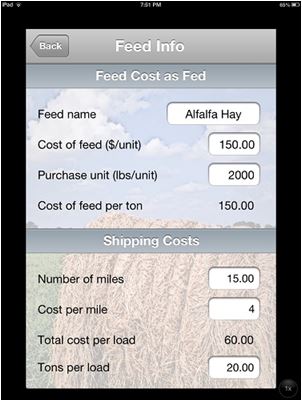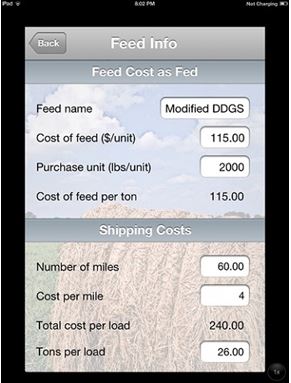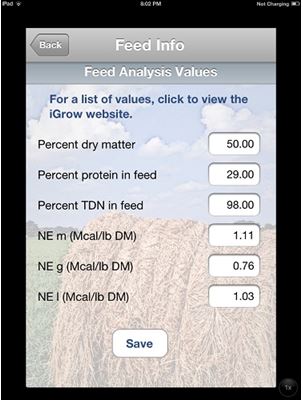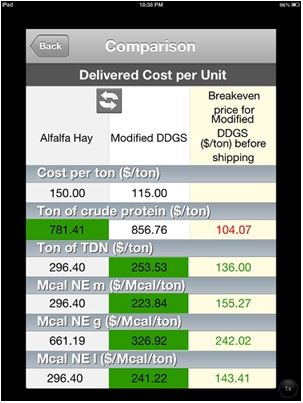 |
April 2014
|
April 2014 // Volume 52 // Number 2 // Tools of the Trade // v52-2tt3
Mobile and Web-Based Applications to Determine the Most Economical Feedstuffs for Livestock
Abstract
Producers are turning to mobile and Web-based decision-making tools in increasing numbers to better manage their businesses. To assist livestock producers in evaluating feed options, a "Feed Cost Calculator" was developed as an app for iOS, Android, and Web-based platforms. Mobile applications are a viable alternative to spreadsheet tools to address the needs of Extension clientele; however, there are certain inherent limitations to using mobile technology that must be considered.
Introduction
Feed costs represent the largest expense for both beef (Garrard & Glaze, 2008) and dairy (USDA, 2013) enterprises. Those expenses have increased dramatically in recent years. Widespread drought conditions in recent years have exacerbated market conditions for feedstuffs. Many producers are considering purchasing feedstuffs they are unfamiliar with feeding, such as commodity by-products.
Choosing between different feed options is not always simple. Factors such as shipping costs, moisture content, and differing nutrient compositions can complicate the decision-making process. Historically, as technology has changed Extension has developed tools to assist producers with those decisions, ranging from hand-held programmable calculators (Campbell, 1979) to modern spreadsheet applications (Howard & Shaver, 1997).
The advent of the smartphone and mobile technology is moving the decision-making process away from the office. This trend has significant implications regarding program delivery and outreach efforts for Extension as it responds to clientele needs (Drill, 2012). According to a survey of farmers conducted by Successful Farming magazine in 2011, 43% of farmers with a mobile phone use a smart phone (Walter, 2011). An August 2012 survey of farmers attending the Dakotafest trade show in Mitchell, SD showed that 76% of respondents either owned or planned on buying a smartphone or tablet within 12 months (E. Tschetter, personal communication).
Application Development
The Feed Cost Calculator app was developed to help producers efficiently compare two feedstuffs on a cost-per-nutrient basis, taking into account differences in moisture content, nutrient composition, and transportation expenses. The initial tool was written as a Microsoft Excel spreadsheet and then developed into applications for both the Android and iOS platforms by the South Dakota State University Office of Information Technology. The applications were then made available as free downloads from the Google Play Store and iTunes, respectively. The Feed Cost Calculator is also available as a Web-based spreadsheet tool at iGrow.org (Renelt & Rusche, 2012).
Data Entry
When the application is launched, the first screen that appears shows the feeds that are available to compare (Figure 1). The app is populated with a built-in library of feeds commonly utilized in the upper mid-west. Default values for nutrient composition for these feeds were are also included (Preston, 2012). Users can override these values based on their own analyses or add additional feedstuffs.
Figure 1.

The data entry screens for two example feedstuffs are shown in Figures 2-5. The available data fields are as follows:
- Cost of the feed (required)
- Size of the unit being purchased (required)
- Shipping costs (optional)
- Percent dry matter (required)
- At least one of the following nutrient values is required:
- Percent crude protein
- Percent TDN
- Net Energy for maintenance
- Net Energy for gain
- Net Energy for lactation
In these examples, all the nutrient composition fields are utilized, however if for example the user was only interested in crude protein, the energy fields could be left blank.
Figure 2.

Figure 3.

Figure 4.

Figure 5.

Data Output
After the data for the feedstuffs are entered and saved, two feeds can then be selected and compared. The nutrients for which a feedstuff is a better buy are highlighted in green on the output screen (Figures 6 and 7). In this example, modified DDGS (dried distillers grains with solubles) offers a more economical source of dietary energy than would alfalfa hay, while alfalfa is the cheaper source of crude protein. The breakeven price is also shown. In this case, if modified DDGS cost less than $104.63 per ton before shipping costs, it would be the more economical source of crude protein (Figure 6). Selecting the double arrow icon would reverse the feeds selected as shown in Figure 7. Doing so in this example would show that alfalfa hay would have to cost less than $127.87 per ton before shipping in order to be a more economical source of total digestible nutrients (TDN).
Figure 6.

Figure 7.

Feed Cost Calculator Application Usage
The total number of downloads by platform and the number of Web page visits as of July 2013 are shown in Table 1 (L. Gerard, personal communication, 2013). The application was advertised and promoted through SDSU Extension's iGrow.org website, as well as through social media and national and regional media outlets. Recently the application was named as one of the top ten business applications for farmers by Agriculture.com (Looker, 2013).
| Platform | Downloads/Page Views |
| Android | 1491 |
| iOS | 1492 |
| iGrow.org web page | 1396 |
Limitations
The application is designed to compare feeds based on single nutrients. Some nutritionists suggest that simultaneously using the price per unit of protein and energy is a more accurate method to determine the true value of a feedstuff (Garcia & Diaz-Royon, 2012), particularly for by-product feeds that are relatively high in both energy and protein. However, this would require the user to enter two additional reference feedstuffs (typically corn and soybean meal) in order to establish the value of a unit of energy and protein.
While using both protein and energy simultaneously is a more accurate measure of true value, this application is designed as a quick tool for use on handheld devices. Many times a user simply needs to know the least expensive source of either dietary protein or energy. Where a more in-depth analysis is required, this app can be used as a preliminary tool to determine if a more robust examination is warranted.
Summary
Modern livestock production continues to become more challenging and complex. In order to meet these challenges, progressive livestock producers will expect advanced decision making tools that reflect their use of technology. Extension will need to adapt to this changing environment to meet the needs of this clientele base.
Acknowledgments
The authors gratefully acknowledge the assistance of the following individuals:
- Emery Tschetter, SDSU Extension Director of Communication & Marketing
- Lindsey Gerard, SDSU Extension iGrow Technology Coordinator
- SDSU Office of Information Technology
- Erik Ebsen
- Daniel Jamison
- Terry Molengraaf
- Sandeep Patel
References
Campbell, J. K. (1979). Little package, big deal. Journal of Extension [On-line], 17(3). Available at: http://www.joe.org/joe/1979may/79-3-a7.pdf
Drill, S. L. (2012). Mobile applications for Extension. Journal of Extension [On-line], 50(5) Article 5TOT1. Available at: http://www.joe.org/joe/2012october/tt1.php
Garcia, A., & Diaz-Royon, F. (2012). Consider protein, energy when pricing low-fat DDGS. Feedstuffs, 84, 10-11. Retrieved from: http://fdsmagissues.feedstuffs.com/fds/PastIssues/FDS8431/fds10_8431.pdf & http://fdsmagissues.feedstuffs.com/fds/PastIssues/FDS8431/fds11_8431.pdf
Garrard, R. M., & Glaze, J. B. (2008). Supplement allows ranchers to eliminate hay feeding and reduce winter feed costs. Journal of Extension [On-line], 46(3) Article 3IAW6. Available at: http://www.joe.org/joe/2008june/iw6.php
Howard, W. T., & Shaver, R. D. (1997). FEEDVAL: Comparative values calculated from crude protein, TDN, Ca and P referee feeds used to calculate value of nutrients. Retrieved from: http://www.uwex.edu/ces/dairynutrition/documents/FEEDVALComparativeweb.xls
Looker, D. (2013). Business apps. Retrieved from: http://www.agriculture.com/farm-management/technology/business-apps_322-ar30214
Preston, R. L. (2012). 2012 feed composition tables. Retrieved from: http://beefmagazine.com/datasheet/2012-feed-composition-tables
Renelt, T. E., & Rusche, W. C. (2012). Feedstuff cost comparison. Retrieved from: http://igrow.org/livestock/beef/feedstuff-cost-comparison/
Walter, J. (2011). More smartphones go to the field this spring. Retrieved from: http://www.agriculture.com/news/technology/me-smartphones-go-to-field-this-spring_6-ar15872
USDA. Economic Research Service. (2013). U.S. Monthly dairy costs of production. Retrieved from: http://www.ers.usda.gov/datafiles/Milk_Cost_of_Production_Estimates
/Milk_CostofProduction_Estimates2010_Base/Monthly/
nationalmonthlymilkcop2010base.xls




